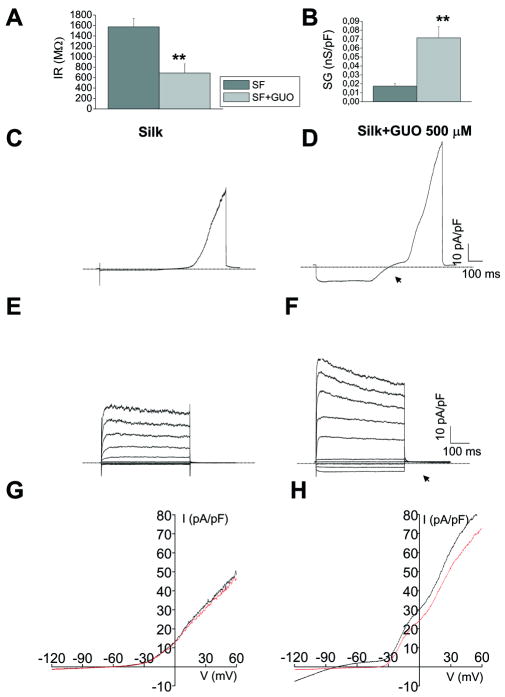Figure 5.
A-B) Passive properties of cells plated on silk and silk+GUO. A:Histogram of the mean values of input resistance (IR) in untreated (n =26, gray bar) and Guo-treated astrocytes (n = 20, light gray bar). B:histogram plot of the mean normalized conductance (specific G, SG) showing a five-fold increase in Guo-treated cells compared to untreated silk-cells (n =20) **p < 0.01 (Student's t-test). C-D). Typical current traces evoked from a holding potential (Vh) of -60 mV stimulating astrocytes with a voltage ramp from -120 to +60 mV (1000 ms), after a 500-ms-long step potential to -120 mV (inset to Fig 3A), indicate that in astrocytes (left) plated on silk displayed only voltage-dependent outward rectifying K+ conductance (Figure 3). (E-F) Current profile of astrocytes plated on silk+GUO coated coverslips. Note that in response to hyperpolarizing stimulus and inward conductance (arrowhead) is displayed only by silk+GUO treated cells in D and F.
G-H) Typical IV current plot of ramp current traces elicited in silk cells (G) and silk+GUO cells (H) before (black trace) and after (red trace) extracellular superfusion of submillimolar concentrations of barium (Ba2+, 200 μM). Note inhibition by Ba2+ of currents elicited at potentials between -80 and -40 mV when the delayed rectifier K+ current was not activated. Also outward currents in Guo-treated astrocyte were also partially inhibited, suggesting weak rectification profile of Kir conductance.

